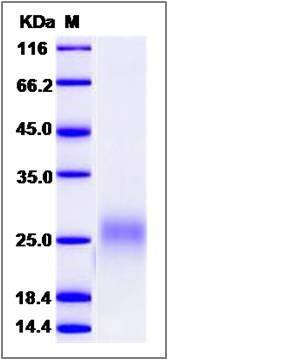Human FLT3L / Flt3 ligand / FLT3LG Protein (His Tag)
FL,FLT3L,FLT3LG
- 100ug (NPP1287) Please inquiry
| Catalog Number | P10315-H07B |
|---|---|
| Organism Species | Human |
| Host | Baculovirus-Insect Cells |
| Synonyms | FL,FLT3L,FLT3LG |
| Molecular Weight | The recombinant human human FLT3LG consists of 175 amino acids and predicts a molecular mass of 20.2 KDa. It migrates as an approximately 27 KDa band in SDS-PAGE under reducing conditions. |
| predicted N | His |
| SDS-PAGE |  |
| Purity | > 95 % as determined by SDS-PAGE |
| Protein Construction | A DNA sequence encoding the human FLT3LG (P49771-1) (Thr27-Pro185) was expressed, with a polyhistidine tag at the N-terminus. |
| Bio-activity | |
| Research Area | Immunology |Cluster of Differentiation (CD) |B Cell CD Antigen |
| Formulation | Lyophilized from sterile 20mM Tris, 500mM NaCl, pH 7.4 1. Normally 5 % - 8 % trehalose and mannitol are added as protectants before lyophilization. Specific concentrations are included in the hardcopy of COA. |
| Background | FLT3L, also known as flt3 ligand, is a small molecule that acts as a growth factor that increases the number of immune cells by activating the hematopoietic progenitors. In vivo, FLT3L also induces the mobilization of the hematopoietic progenitors and stem cells. This may help the system to kill cancer cells. Dendritic cells (DCs) provide the key link between innate and adaptive immunity by recognizing pathogens and priming pathogen-specific immune responses. FLT3L controls the development of DCs and is particularly important for plasmacytoid DCs and CD8 -positive classical DCs and their CD103 -positive tissue counterparts. |
| Reference |
